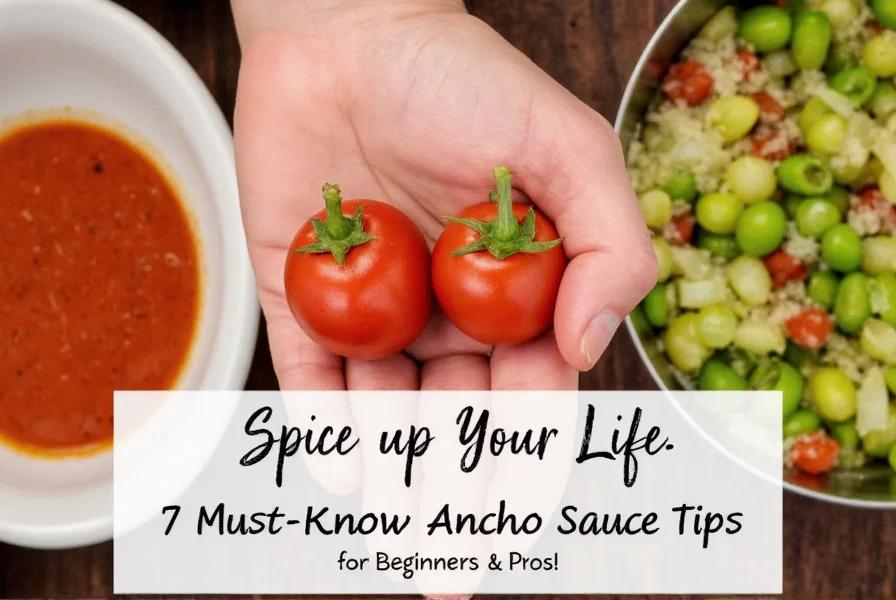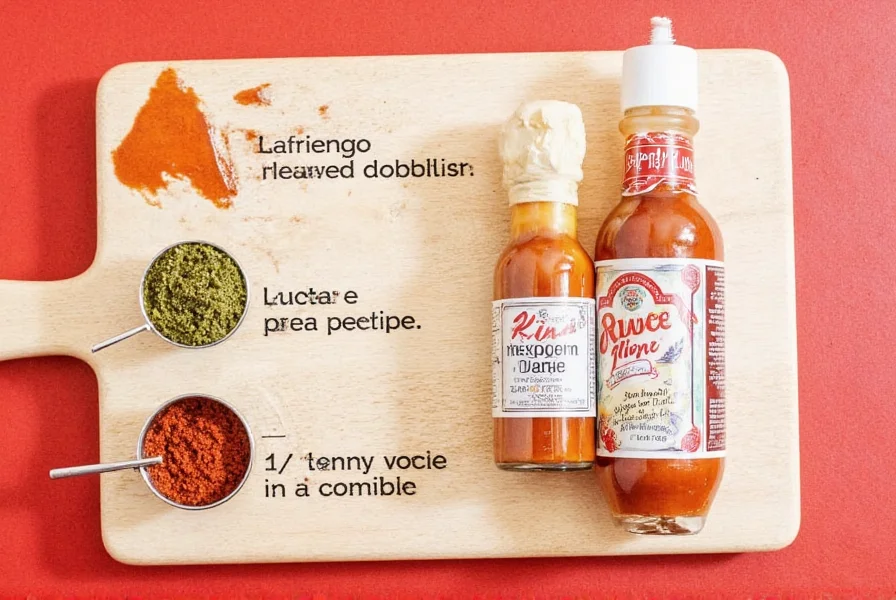Ancho sauce is a traditional Mexican condiment made from dried poblano peppers, offering a mild heat level (1,000-2,000 SHU) with complex flavors of sweet dried fruit, earthy smoke, and subtle warmth. Unlike hotter sauces, ancho sauce provides rich depth without overwhelming spice, making it versatile for everyday cooking. This guide explains exactly what ancho sauce is, how it differs from similar sauces, and the best ways to use it in your kitchen.
| Key Fact | Detail |
|---|---|
| What it is | Rehydrated and blended dried poblano peppers |
| Heat level | Mild (1,000-2,000 Scoville units) |
| Flavor profile | Sweet prune/raisin notes, earthy, smoky, subtle heat |
| Best uses | Marinades, soups, enchiladas, dips, and chocolate pairings |
| Ancho vs Chipotle | Ancho = dried poblano (milder); Chipotle = smoked jalapeño (hotter) |
Table of Contents
- What Is Ancho Sauce? (Dried Poblanos Explained)
- Ancho Sauce Flavor Profile: Mild Heat With Complex Notes
- Ancho Sauce vs Chipotle: Key Differences You Need to Know
- 7 Practical Ways to Use Ancho Sauce in Everyday Cooking
- Where to Buy Ancho Sauce: Top 4 Brands Compared
- How to Make Homemade Ancho Sauce (5-Ingredient Recipe)
- Best Dishes for Ancho Sauce: From Tacos to Desserts
- Ancho Sauce FAQ: Quick Answers to Common Questions
What Is Ancho Sauce? (Dried Poblanos Explained)
Ancho sauce is made exclusively from dried ancho peppers, which are simply matured, dried poblano peppers. The name "ancho" means "wide" in Spanish, describing the pepper's broad shape. When fresh poblanos ripen to red and are dried, they transform into anchos with concentrated flavors that include notes of dried fruit, cocoa, and subtle smoke.
This isn't just another hot sauce—authentic ancho sauce contains no vinegar or preservatives, just rehydrated peppers blended with minimal seasonings. It serves as a foundational ingredient in traditional Mexican cooking, particularly in moles and complex sauces where depth matters more than heat.
Ancho Sauce Flavor Profile: Mild Heat With Complex Notes
Understanding ancho sauce's unique flavor profile explains why chefs reach for it instead of standard hot sauces:
| Flavor Element | Description |
|---|---|
| Heat Level | Mild (1,000–2,000 SHU) - noticeably less spicy than jalapeños |
| Sweetness | Natural fruit sugars from dried peppers (reminiscent of prunes) |
| Smokiness | Earthy, woodsy notes from the drying process |
| Fruitiness | Distinct dark fruit undertones, unlike fresh green peppers |
| Umami | Rich depth that enhances savory dishes without overpowering |
Ancho Sauce vs Chipotle: Key Differences You Need to Know
Many confuse these two popular Mexican sauces, but they're fundamentally different:
- Ancho sauce: Made from dried poblanos; mild heat (1,000-2,000 SHU); sweet, fruity flavor; deep red color
- Chipotle sauce: Made from smoked jalapeños; significantly hotter (2,500-8,000 SHU); pronounced smokiness; tan to brown color
The confusion often comes from labeling—some brands misleadingly call chipotle sauce "ancho." Check ingredients: authentic ancho sauce contains only dried poblano peppers, water, and minimal seasonings.
7 Practical Ways to Use Ancho Sauce in Everyday Cooking
- Quick marinade for weeknight dinners
Combine 2 tbsp ancho sauce with 1 tbsp lime juice and 1 tsp garlic powder for a 15-minute chicken or tofu marinade. - Instant soup upgrade
Add 1-2 tbsp to canned tomato soup or black bean soup for restaurant-quality depth. - Breakfast boost
Mix into scrambled eggs or avocado toast for a savory morning kick. - Easy taco enhancement
Thin with a little orange juice for a glaze on fish or carnitas tacos. - Simple dip base
Blend ¼ cup with Greek yogurt and cilantro for a healthy vegetable dip. - Unexpected dessert pairing
Add ½ tsp to chocolate brownie batter or hot cocoa for subtle warmth. - Long-term storage hack
Freeze in ice cube trays (1 tbsp per cube) for ready-to-use portions lasting 6 months.
Where to Buy Ancho Sauce: Top 4 Brands Compared
When shopping for store-bought ancho sauce, watch for these key factors:
| Brand | Authenticity Check | Best For | Avoid If |
|---|---|---|---|
| Mi Costeño Ancho Chile | ✓ Only peppers, water, salt | Daily cooking, mole bases | You want ready-to-eat sauce (requires cooking) |
| La Morena Ancho Salsa | ✓ Traditional preparation | Tacos, enchiladas | You need gluten-free (contains wheat) |
| Goya Ancho Puree | ✗ Added preservatives | Quick recipes, baking | You prefer all-natural ingredients |
| Hatch Ancho Chile Sauce | ✓ Simple ingredients | American-style dishes | You want authentic Mexican flavor |

How to Make Homemade Ancho Sauce (5-Ingredient Recipe)
Creating authentic ancho sauce takes just 20 minutes with basic ingredients:
- Ingredients:
- 5 dried ancho peppers (check for deep red color, pliable texture)
- 1½ cups hot water (for soaking)
- 1 garlic clove
- Salt to taste
- Step-by-Step:
- Remove stems and seeds from peppers. Place in bowl and cover with hot water. Soak 15 minutes until soft.
- Drain peppers, reserving ½ cup soaking liquid. Place peppers in blender with garlic, cumin, and salt.
- Add soaking liquid gradually while blending until smooth (about 2 minutes).
- Strain through fine mesh sieve for silky texture (optional but recommended).
- Store in airtight container: lasts 1 week refrigerated or 6 months frozen.
- Weeknight enchiladas - Use as base instead of green sauce for richer flavor that complements cheese fillings
- Breakfast migas - Stir 1 tbsp into eggs with tortilla strips and tomatoes
- Quick mole chicken - Simmer with chicken thighs, chocolate, and sesame seeds for authentic Oaxacan flavor
- Vegetable glaze - Thin with orange juice for roasted sweet potatoes or carrots
- Chocolate pairing - Add ½ tsp to brownie batter or hot cocoa for subtle warmth
½ tsp cumin Best Dishes for Ancho Sauce: From Tacos to Desserts

Ancho Sauce FAQ: Quick Answers to Common Questions
How spicy is ancho sauce compared to other peppers?
Ancho sauce measures 1,000-2,000 Scoville Heat Units (SHU), making it milder than jalapeños (2,500-8,000 SHU) and significantly less spicy than habaneros (100,000-350,000 SHU). The heat is subtle and balanced by natural sweetness, so most people find it approachable even if they're sensitive to spice.
Can I substitute ancho sauce for tomato paste?
Yes, use a 1:1 substitution in stews, braises, or chili for added depth and complexity. Unlike tomato paste, ancho sauce brings smoky, fruity notes without acidity. Reduce other liquids slightly since ancho sauce contains more moisture.
Why does my ancho sauce taste bitter?
Bitterness usually comes from over-soaking peppers (limit to 15-20 minutes) or including too many seeds/membranes. For sweeter results, remove all white ribs and seeds before soaking, and add ¼ tsp honey when blending.
Is ancho sauce the same as chili powder?
No. Ancho sauce is made purely from rehydrated ancho peppers, while chili powder is a spice blend containing multiple peppers, cumin, garlic powder, and other seasonings. For authentic Mexican flavor, use pure ancho sauce rather than chili powder blends.
What's the difference between ancho and mulato peppers?
Both are dried poblanos, but harvested at different stages. Anchos come from fully red-ripened poblanos (sweeter, fruitier), while mulatos come from overripe poblanos (darker, more chocolate notes). In sauce form, anchos are brighter red with lighter flavor.
Can I use ancho sauce in place of adobo sauce?
Not directly—they have different flavor profiles. Adobo sauce contains vinegar and is tangier. To substitute, mix ancho sauce with 1 tsp vinegar and ½ tsp smoked paprika per tablespoon of adobo sauce required.










 浙公网安备
33010002000092号
浙公网安备
33010002000092号 浙B2-20120091-4
浙B2-20120091-4